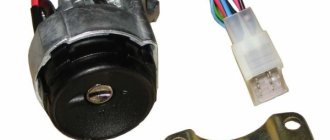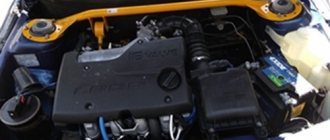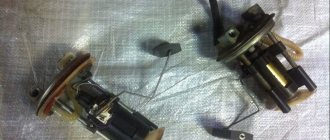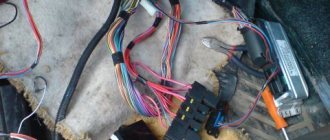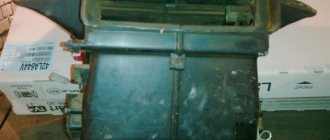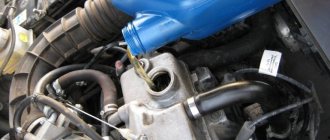What is an injector - a modern replacement for a carburetor
An injector is a device that replaces the operation of a carburetor and consists of a fuel rail (rail) onto which injectors are attached. Under high pressure from the gasoline pump, fuel enters the rack, and from there the gasoline is distributed to the injectors. The injector nozzles, using rubber sealing rings, are inserted together with the rack into the engine block and inject fuel, which then ignites.
One of the main parts of the work in the injector is performed by the intake manifold. Its device includes a throttle valve, which is responsible for supplying air from the environment to the engine block.
An injector is a fairly thin device, the operation of which is constantly regulated by the electronic “brain” of the car. The presence of an on-board computer allows specialized car repair shops to carry out quick and accurate vehicle diagnostics. Diagnostics is carried out by connecting special equipment through a connector to the vehicle’s on-board computer.
Injection models of the VAZ 21099 since 2000 have also acquired electronic “brains”. This car model has front-wheel drive and shows high road stability. The engine of the injection 99 is four-cylinder, eight-valve, with a displacement of 1.5 liters. In a modern VAZ, the maximum speed indicated on the speedometer is 180 km/h. In practice, it is not recommended to accelerate this car over 160 km/h.
A design feature of a car injector is much lower fuel consumption compared to a carburetor car. VAZ 21099 (injector) has an average consumption of 7.0–7.5 liters per 100 km, at an average speed of 100–120 km/h. It was possible to achieve a reduction in fuel consumption by reducing the vehicle's energy consumption. It is worth noting that the injector of this car is not very picky about octane fuel and consumes the same gasoline, both A-92 and A-95.
Expert opinion
Ruslan Konstantinov
Automotive expert. Graduated from Izhevsk State Technical University named after M.T. Kalashnikov, specializing in “Operation of transport and technological machines and complexes.” More than 10 years of professional car repair experience.
The injection engine today is much more popular than the carburetor. It is not surprising, because the advantages are obvious: • the engine operating mode is selected automatically; • there is no need for manual configuration, the human factor is eliminated; • fuel economy; • compliance with environmental standards; • does not lose power and can start without problems in any conditions. However, the injector is not without its disadvantages: • higher cost, including maintenance; • sensors cannot be repaired and should be replaced with new ones; • without special equipment and skills, it is difficult to repair the injector yourself; • engine operation depends on the on-board network voltage. As for the efficiency of injection engines, experienced carburetor tuning specialists can argue with this. After proper adjustment, the carburetor consumes even less fuel than the injector. But the engine power also becomes less. Motorists of the old school prefer not to switch to an injector at all because of its sensitivity to fuel quality. Be that as it may, the carburetor will eventually be completely inferior to modern technology.
Diagram of the power supply system for injection engines of VAZ 2108i, 2109i, 21099i (EURO-2) cars
The power supply system for injection engines of VAZ 2108i, 2109i, 21099i cars is designed to ensure an uninterrupted supply of fuel to the engine cylinders.
In addition, it has the functions of storing a certain supply of fuel on board the vehicle and cleaning it from mechanical contamination. diagram of the power supply system for the injection engine of VAZ 2108, 2109, 21099 cars (EURO-2 toxicity standards)
Elements of the power supply system for injection engines of VAZ 2108i, 2109i, 21099i cars
— The fuel tank is welded, welded from two stamped halves. Capacity 43 liters. The filler neck is located in the right rear fender of the car.
— The fuel module (electric fuel pump) is installed in the fuel tank and combines a fuel pump and a fuel level indicator sensor. To access the module, there is an inspection hatch under the rear seat in the car body. A fuel purification strainer is installed on the inlet pipe of the fuel module.
— fuel filter in a metal casing, not dismountable, is installed under the bottom of the car, next to the fuel tank.
— The fuel rail supplies fuel from the supply line to the four injectors inserted into it. The connection between the ramp and the injectors is sealed with rubber rings. At the end of the ramp there is a diagnostic fitting for measuring pressure in the system.
— An injector is an electromagnetic valve that allows fuel to flow into the cylinders when voltage is applied to it and closes when there is no power under the action of a return spring. At the end of the injector there is a nozzle through which fuel is injected into the intake manifold. The injection system controller controls the injectors.
— Fuel pressure regulator – bypass valve installed on the fuel rail. It maintains the required operating pressure in the fuel line (around 3 atmospheres). And it changes depending on the engine speed. Excess fuel is discharged back into the fuel tank via the return line.
— Separator – element of the fuel vapor recovery system (under EURO 2). Fixed under the rear right fender of the car. In it, gasoline vapors condense and return back to the fuel tank. Fuel vapors that have not had time to condense enter from the separator into the adsorber.
— Adsorber - a container (element of the fuel vapor recovery system), where fuel vapors coming from the separator are absorbed by activated carbon. When the engine crankshaft speed increases, the control unit gives a command to open the canister purge valve and gasoline vapors are sucked into the intake module receiver. Installed in the engine compartment.
— The gravity valve prevents fuel from leaking out of the fuel tank when the vehicle turns over.
— A two-way valve prevents excessive increase or vice versa decrease in pressure in the fuel tank.
Notes and additions
— Elements of the fuel vapor recovery system (separator, adsorber) are available only on VAZ 2108i, 2109i, 21099i vehicles that comply with EURO 2 standards.
Malfunctions of VAZ 21099 - the injector also fails!
Regardless of the time of year outside, very often the car may simply stop starting, or begin to respond poorly to the gas pedal. In this case, all on-board computer sensors may not show errors. The causes of failure should be sought in the injector.
Usually the breakdown is associated with clogging of the fuel injector nozzles, which increases fuel consumption in the car and reduces traction. Due to the fact that the fuel does not enter in the quantity required for engine operation, the idle speed begins to float. For a VAZ, the normal value when the engine is idling in warm weather is 900 rpm. When starting in the cold season, the engine produces 1500 rpm; with proper operation, after 5–10 minutes they should drop to 900.
It is also worth paying attention to the throttle valve of the intake manifold - over time, black deposits appear on it, which prevents it from properly passing air. It is enough to clean the damper with a special spray and gently wipe with a cloth - the problem is eliminated!
Content
The injector is controlled by electronic signals that come from the processor
, and he, in turn, in order to issue them, tracks signals from sensors installed on and in the engine.
The only work that can be done on an injection engine to adjust it and stabilize its operation is flushing the injector, or more precisely, flushing the injectors.
Where is the temperature sensor located?
If the device panel does not indicate a temperature sensor, there is a greater risk of overheating the engine, because the dashboard does not inform the driver about the heating of the cooling water of the internal combustion engine (internal combustion engine). Obviously, the instrument panel or wiring may be faulty, but most often the temperature sensor (DTOZH) on the engine itself refuses to work.
Where is the temperature sensor located on an injection car 099? Naturally, it must be found in the engine department:
- open the hood;
- we find the wiring that is located between the rear part of the engine valve cover and the air filter housing;
- where the DTOZH is located can be seen most carefully in the following photos.
Where is the starter relay located?
Just like the engine cooling fan, the starter is controlled by a relay, and due to its malfunction the following problems may occur:
- when you turn the ignition key, nothing happens, the engine does not show any signs of life;
- When I try to start the engine, clicks are heard, but the starter does not crank.
Finding out where the starter relay is located on a VAZ-21099i car is very simple; to do this, you just need to open the hood of the car and look behind the air pipe of the injection engine; the part you are looking for is shown below in the picture.
Where is the fuel filter located?
The fuel filter (TF) on the VAZ-21099i is designed to clean gasoline from debris, dirt and various impurities; it is a one-piece system with a solid iron body and a filter element inside. The frequency of its replacement is after any 20-30 thousand km of the distance traveled, also if the car begins to move jerkily, and diagnostics (the process of establishing a diagnosis, that is, a conclusion about the nature of the disease and the patient’s condition)
showed that the TF was clogged.
It is not difficult to find out where the fuel filter is located; to do this, you need to install the car on an inspection hole or a car lift. The TF is located on the bottom of the body, next to the rear support and the gas tank, and is secured with a special clamp, which is tightened with a bolt and nut.
Before you start changing the filter, you need to release the fuel pressure, otherwise, when you unscrew the fuel fittings, gasoline will spray out under enormous pressure. You can relieve pressure in the line using a special nipple located at the rear of the fuel rail. Before starting such an operation, you need to prepare a plastic container into which to pour gasoline, and then unscrew the safety cap.
To release the pressure, you can use a regular flat-head screwdriver; when you press the nipple valve, gasoline will come out of the system.
After removing the fuel from the line, we proceed to replacing the TF.
Source: avtobrands.ru
Where is the speed sensor located?
The speed sensor (DS) on front-wheel drive VAZ cars reads pulses depending on wheel speed and transmits the data to the electrical control unit (ECU). When the engine brakes, the fuel supply is turned off with the help of the engine and the computer, thus achieving the most economical operation of the internal combustion engine. If the sensor is faulty, an error code is recorded, gasoline consumption increases slightly, and idle speed decreases, especially during heavy braking. Where the speed sensor is located is difficult to find right away, because it is hidden under the air filter housing (AFC).
We find the part that suits us as follows:
- open the hood of the car;
- Using a 10mm wrench, unscrew the two KVF fastening bolts;
- loosen the clamp of the air “corrugation”, disconnect the “chip” with the wires;
- we take out the KVF, now the sensor has already appeared in the field of view, it is located on the gearbox body (gearbox (Checkpoint is a point designed to control passage (visit) and access to the territory of any facility)
), wires connect to it using a connector.
